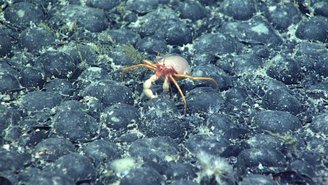The universally accepted belief that photosynthesis by plants, algae and cyanobacteria is the main source of oxygen production on our planet may have crashed to the bottom of the Pacific Ocean, 4,000 metres. It was in this lightless scenario that scientists discovered the metallic minerals that produced the vital gas..
The discovery was made by chance by a team from the Scottish Society for Marine Science (SAMS), who were measuring oxygen levels at the bottom of the ocean to assess the effects of deep-sea mining.
“When we first got this data, we thought the sensors were faulty because every deep-sea study we’ve done so far has been They just observed that oxygen was being consumed rather than produced.” he explained in a statement. The sensors were recalibrated, but the strange readings continued for a decade.
How do polymetallic nodules produce dark oxygen?
To alleviate their doubts, the researchers decided to abandon the optode sensors (which measure the oxygen concentration in the water), but the other method used gave the same results. Knowing that something unusual had happened, they collected some rocks from the analyzed nodules and tested them in the laboratory.
Although these metals are combined in nodules, some of them attracted the attention of the authors, Elements such as cobalt, nickel, copper, lithium and manganese are the main elements used in batteries.This potential, which makes them attractive to deep-sea mining companies, may be responsible for the spontaneous reactions.
During the tests, the researchers discovered some unique polymetallic nodules that produced voltages of up to 0.95 V. This means that when clustered together, these formations could work like series-connected batteries and could easily reach the 1.5 V voltage needed to produce electrolysis in water by splitting oxygen. “It looks like we’ve discovered a natural ‘geobataria'”said co-author Franz Geiger.
The importance of dark oxygen in the emergence of life on Earth

These polymetallic nodules, distributed over large areas of the seabed, form mineral concentration areas consisting of concentric layers of various materials deposited around a core. The possibility of oxygen being called “dark” It is surprising that it is naturally synthesized by Sweetman away from sunlight.
SAMS oceanographer Nicholas Owens, who was not involved in the research, emphasized in an interview with ScienceAlert that “the discovery of oxygen production by a non-photosynthetic process requires us to rethink how the evolution of complex life on the planet may have begun.” According to the expert, this could be one of the most exciting discoveries in ocean science in recent times.
Stay up to date with the latest discoveries in science and chemistry at TecMundo. Or take the opportunity to understand how the Earth’s core may have been covered by an ancient ocean floor.
Source: Tec Mundo
I’m Blaine Morgan, an experienced journalist and writer with over 8 years of experience in the tech industry. My expertise lies in writing about technology news and trends, covering everything from cutting-edge gadgets to emerging software developments. I’ve written for several leading publications including Gadget Onus where I am an author.













